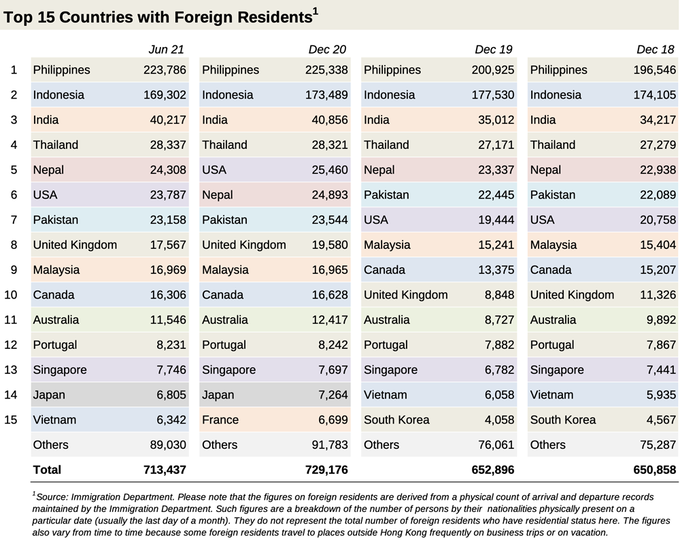Hong Kong's Foreign Residents Stay Put
Any impact on banking from a declining population will be dampened by the high number of foreign residents staying.
The conventional wisdom might dictate that Hong Kong residents, caught between the imposition of last summer’s national security law and the unrelentingly strict COVID-19 containment measures, would be likely to do almost anything to leave the city.
Recently released figures by the Hong Kong Census and Statistics Department seem to bear this out, with the city’s total population falling 1.2 percent to 7.39 million in June from a year earlier. That in itself followed a similar year-on-year percentage fall reported at the end of 2020.
But behind the predictable reports about the mass exodus ostensibly underway is a surprising fact from the Immigration Department. The number of foreign residents in the city was 713,437 in June (see table below). Although this is down a very modest 2 percent from the end of last year, it is still almost 10 percent higher than in 2018, before the start of city-wide pro-democratic protests.
Staying Put
So, what gives? Nobody truly knows as each department seems to be counting somewhat similar but completely different things even though both buildings are so close together that the employees can likely wave at each other.
The census counts inflows and outflows of all residents over an annual or bi-annual timeframe while immigration keeps tabs on the total number of foreign residents located here on a specific day at the end of each stated reporting period.
In fact, the only things both don’t seem to specifically count are Hongkongers with a Special Administrative Region (SAR) passport - living here or abroad.
Anglo-Saxons Undeterred
The U.S. is a prime example of recent trends for countries with strong financial sectors and high numbers of bank industry employees. It has 23,787 residents in the city which, even though the number is down slightly since the end of last year, it is still 22 percent higher than at the end of 2019, which seems ironic given the fraught trade and geopolitical relationship with China.
Looking past the bulk of foreign residents, which comprise Philippine and Indonesian citizens frequently working here as domestic helpers or in the catering, hospitality, and entertainment sectors, it seems that the numbers for many countries have risen significantly.
India, also a strong industry employer, shows much the same, with the number of its residents being 18 percent higher than in 2018 while the number of U.K. residents has almost doubled from the end of 2019. Other relevant countries in the top 15, including Australia, Canada, Japan, and Singapore, mirror the same trend.
Swiss Sonderfall
The number of Swiss, however, seem to be going in the opposite direction. According to the Consulate General of Switzerland, the number of citizens registered in the city fell 7 percent year-on-year. When asked by finewsasia why people had left, the consulate replied that residents are not queried why they are leaving but it would be safe to assume that 2019’s protests, the national security law and the strict quarantine rules all played a role.
What does it all mean for the Hong Kong's role as a finance and travel hub? Not much. At least not yet. The overall decline in population is still modest and it seems very likely at this juncture that any impact from Hongkongers leaving the city will be absorbed by the high number of foreigners still here, at least in the short and medium term.





























